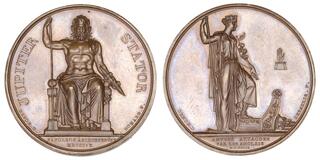| Noonans (formerly Dix Noonan Webb) > Auction 292 | Auction date: 6 March 2024 |
| Lot number: 118 Price realized: 70 GBP (Approx. 89 USD / 82 EUR) Note: Prices do not include buyer's fees. | Show similar lots on CoinArchives Find similar lots in upcoming auctions on |
| Lot description: The Silich Collection of Historical and Art Medals Domard, Joseph François (French, 1792-1858); b. Paris, and Depaulis, Alexis Joseph (French, 1790-1867); b. Paris, and Denon, Dominique Vivant (French, 1747-1825); b. Chalons-sur-Saône FRANCE/AUSTRIA, Anvers attaquée par les Anglais, Séjour à Schönbrünn [English Attack on Antwerp, Napoléon's Stay at Schönbrünn], 1809 [probably struck c. 1820], a copper medal by J.F. Domard and A.J. Depaulis for D.V. Denon, Jupiter seated facing on throne, rev. robed figure of Antwerp standing right, holding spear and caduceus, left foot on prow of ship, couped hand in field, 41mm, 33.30g (Bramsen 870; cf. CGMP p.71; BDM I, 559; Slg. Julius 2128; cf. iNumis MBS 48, 1213). Extremely fine £60-£80 --- Provenance: bt H.D. Rauch, July 2004 In a campaign that cost almost £8 million and was singularly unsuccessful, British troops, in deciding to seal the mouth of the river Scheldt to prevent the port of Antwerp being used as a base against them, occupied the disease-ridden island of Walcheren in September 1809, which had already cost the lives of many French troops earlier in the campaign. The French fleet was ordered to Antwerp and the city heavily reinforced; the British expedition was withdrawn after the loss of 4,000 men, almost all to disease. The Treaty of Schönbrunn, sometimes known as the Treaty of Vienna, was signed between France and Austria at Schönbrunn Palace near Vienna on 14 October 1809, two days after Napoléon narrowly survived an assassination attempt by Friedrich Staps, who refused to apologise to the Emperor and was killed by a firing squad three days later. As both engravers of this medal had not even become students at the École des Beaux-Arts at the time of the events commemorated on it, it is thought that the medal itself was not struck until a decade or more later (cf. Forrer, p.559). |  |


